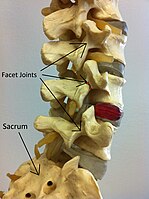
Photo from wikipedia
OBJECTIVE To assess trabecular microarchitecture of spinous process as autograft and investigate its correlations with fusion success and clinical outcomes in patients undergoing posterior lumbar interbody fusion (PLIF). METHODS Micro-CT… Click to show full abstract
OBJECTIVE To assess trabecular microarchitecture of spinous process as autograft and investigate its correlations with fusion success and clinical outcomes in patients undergoing posterior lumbar interbody fusion (PLIF). METHODS Micro-CT reconstruction techniques were utilized to scan cancellous bone specimens from spinous process followed by measuring microarchitectural parameters for 105 subjects. RESULTS The patient cohort was composed of 44 aged men and 61 postmenopausal women with a minimum 2-year follow-up. The complete fusion rate was 87.6% (92/105) at the last follow-up. When stratified by fusion status, the union group had significant higher BS/TV and Tb.N but significant lower Tb.Sp than the nonunion group. In addition, no significant differences were observed between those two groups in clinical variables, excepting BMD at the femoral neck (P = 0.028). In binomial logistic regression analysis, BS/TV was identified as independent predictor for fusion success (OR = 8.532, P = 0.032). Furthermore, ROC curve displayed that BS/TV had excellent performance in predicting successful fusion (AUC: 0.807). Based upon the cutoff value of BS/TV (3.145), higher BS/TV was significantly associated with lower back pain VAS scores since 6 months postoperation and lower ODI scores at at 12 months and 24 months after surgery, but not significantly with leg pain VAS scores. CONCLUSIONS Our data suggested that microstructural deterioration of spinal process as autograft has determent impacts on spinal fusion and clinical outcomes in patients undergoing instrumented PLIF. Specifically, microstructural parameter BS/TV is of good potential in assessing lumbar bone quality and in predicting fusion success.
Journal Title: World neurosurgery
Year Published: 2019
Link to full text (if available)
Share on Social Media: Sign Up to like & get
recommendations!